- Home
- Encyclopedia
- Outfitting In Wyoming
Outfitting in Wyoming
The autumn of 1913 saw the greatest number of high-profile hunting trips northwest Wyoming had ever seen. Wealthy sportsmen and women from around the globe arrived in the dusty outpost of Cody, Wyo. with hopes of bagging memorable trophies and experiencing the last vestiges of the western frontier.
One of these adventure seekers was none other than Prince Albert of Monaco. Having planned to visit Wyoming to hunt and explore the surrounding mountains with A.A. Anderson, the internationally renowned artist and wealthy New Yorker, the prince instead found his visit co-opted by none other than William F. “Buffalo Bill” Cody. Cody saw in the event a means of publicizing his fading prestige and highlighting the recreational opportunities of the Bighorn Basin, in whose development he was heavily invested.
News of the high-profile hunt was broadcast both locally and nationally. As it happened, the story caught the attention of Charles “Spend-A-Million” Gates, heir of the Gates barbed-wire fortune and notorious spendthrift. Well-known around the finer racetracks and gambling resorts of the country, Gates wanted to add the pursuit of game to his resume of lavish pastimes.
Gates had reserved passage on the Lusitania for Europe when he learned of the hunt in Wyoming. Impetuously canceling those arrangements, he instead wired Buffalo Bill, imploring him to wait for his prompt arrival.
Gates arranged for his private Pullman car to whisk him and his entourage to Cody, the literal end of the line. Making their headquarters at Buffalo Bill’s Irma Hotel, Gates and his friends soon learned that their request to join the prince and the famous western showman had been “respectfully but firmly refused”.
Undeterred by the casual snub, the Gates party remained steadfast in their determination for a first-class hunting adventure. To this end they needed assistance from local guides and outfitters. Heading up into the mountains of Wyoming was not a light undertaking. And besides, since 1899 Wyoming law had required non-residents to hire hunting guides to pursue game in the state.
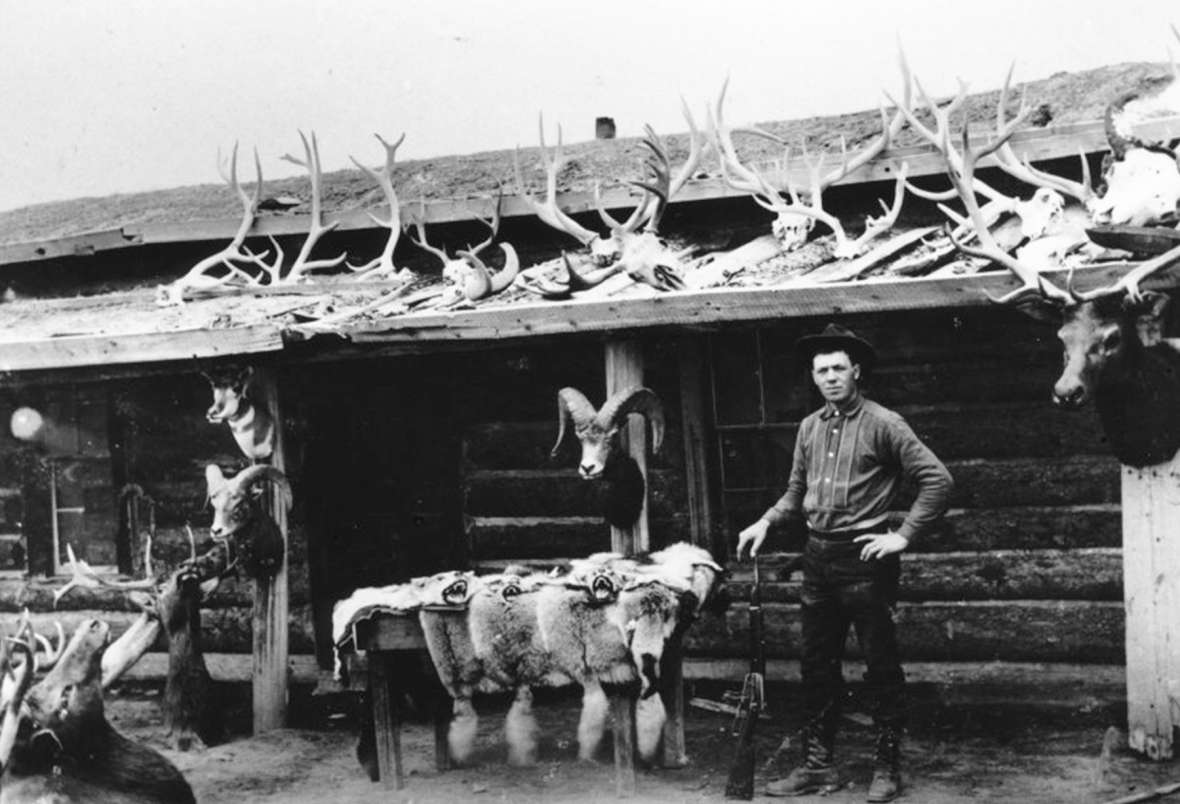
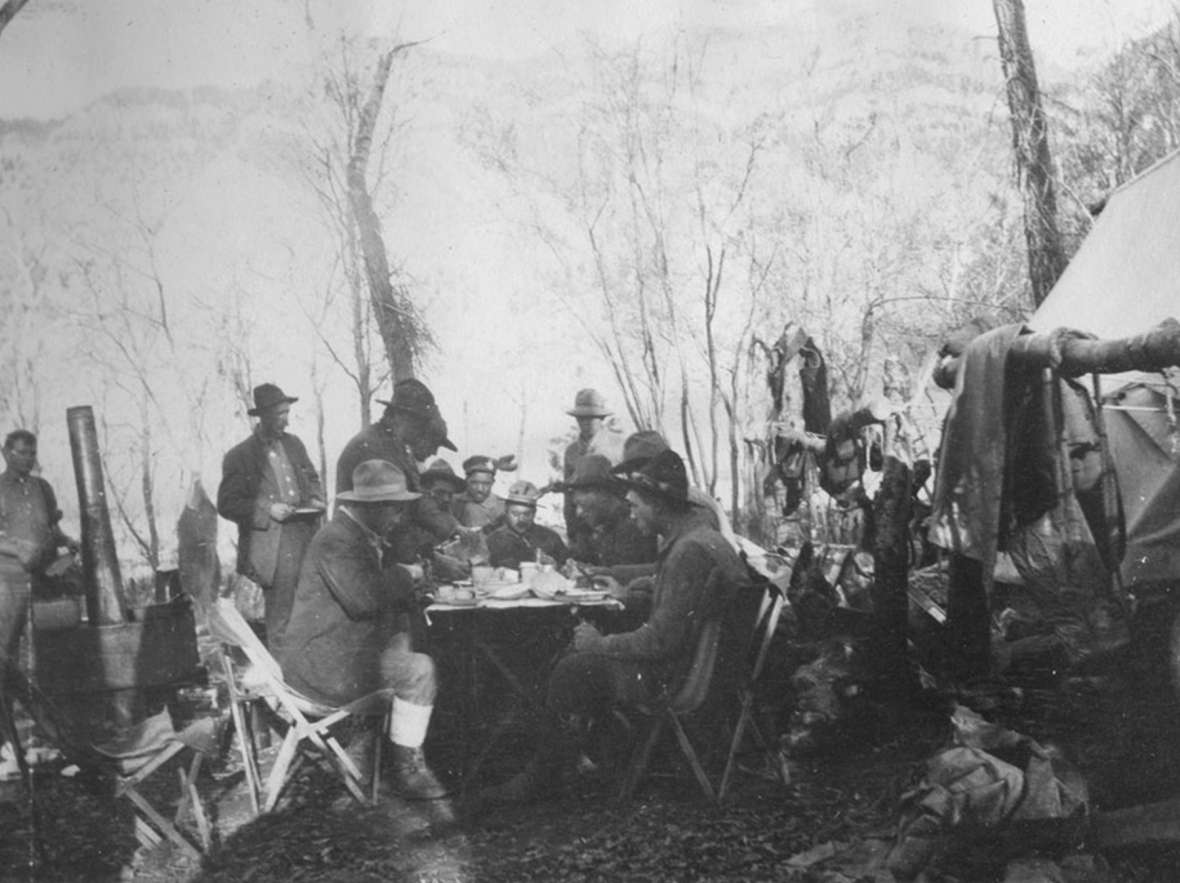
Guiding “Spend-A-Million” Gates
In those days the foremost outfitters and hunting guides around Cody were partners Ned Frost and Fred Richard. Though still young men in 1913, the pair had a great deal of experience guiding paying hunters into the rugged Absaroka Mountains between Cody and Yellowstone National Park. In the fall of 1913, with booming demand for their services, the two men split the simultaneous high-profile hunting trips, Fred Richard guiding the Prince of Monaco and Ned Frost outfitting the “Spend-A-Million” Gates party.
Guiding hunters toward game animals was one thing, but outfitting entire hunting parties on extended expeditions was another—it required a great deal of logistical planning. The Gates party needed 55 pack horses to carry all the supplies and provisions, in addition to the 16 saddle horses for the sportsmen, guides, wranglers, and camp cooks. The group made history when they packed a phonograph over the mountain divide into the remote Thorofare region so the hunters would not be without their aural pleasures while “roughing it.” Ned Frost and his team also rigged one especially sturdy pack horse to tote a primitive battery-operated refrigerator Gates insisted upon.
A story was later told of a pack horse loaded exclusively with liquor that managed to crash into a tree and break its cargo. Gates, knowing his doctors sought to curb his drinking, immediately suspected the accident was an intentional plan to enforce sobriety. Whatever the truth might have been, the party was temperate for the duration of the trip.
Ned Frost and his team erected camp on Thorofare Creek, just below the mouth of Open Creek and just outside the southeast corner of Yellowstone Park, an established backcountry camp still in use today. They christened the site “Camp Lucky”.
And lucky they were. With the help of the guides, Gates and his men bagged 10 bull elk and three mule deer in their month in the wilderness. When not actively pursuing game, the hunters relaxed around camp, eating hearty meals, playing cards and listening to their “canned music.”
The weather was fine throughout most of trip, but near the end of October the group encountered a big snowstorm coming out over the Deer Creek Trail. The outfit shoveled through snow drifts 15-30 feet deep while descending from the mountains.
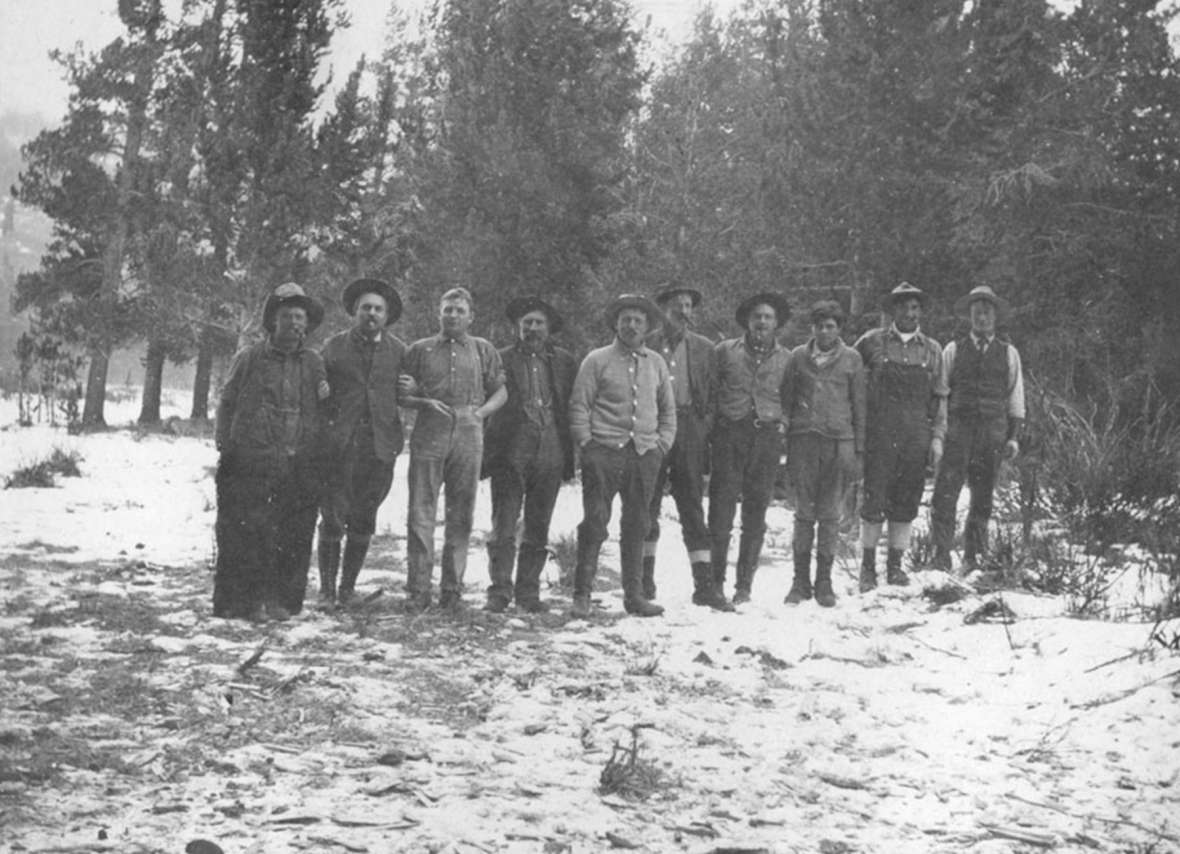
Gates dazzles Cody
On returning to Cody the Gates party made up for their wilderness sobriety. When the leading citizens of town invited their eminent guests on a personal tour of the western community they were rebuffed as Gates instead wished to mingle with the local “rough-necks.”
Living up to his nickname, “Spend-A-Million” Gates doled out lavish gifts upon the wide-eyed townspeople. Many of the guides and camp tenders from the hunting trip were given long coonskin coats, for which Gates spent nearly $7,000 at a local haberdasher. Ned Frost, the outfitter and lead hunting guide, received a tip of $10,000 for his excellent service.
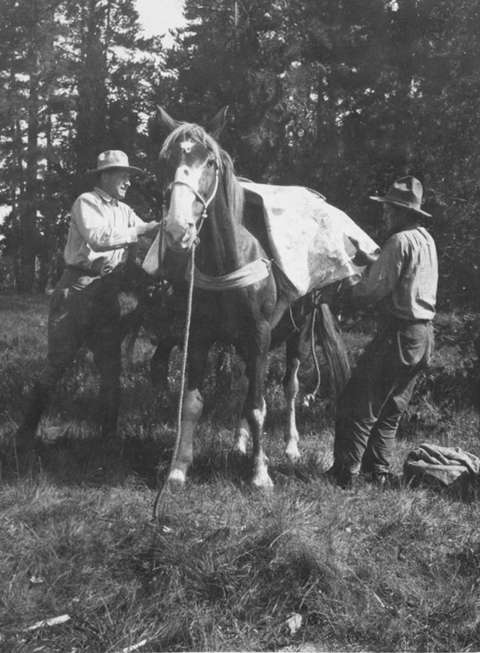
In one particularly generous gesture Gates declared, from his seat at a local saloon, that he would square away the debt of the churches in Cody if their respective ministers presented their statements to him. Gates bestowed so much generosity on the small town that it only seems fitting the grateful inhabitants would give their benefactor a fitting departure.
But the town never had the opportunity. The morning following a spirited night on the town, “Spend-A-Million” Gates died of apoplexy in his private Pullman car at the Cody depot. The town was shocked and saddened.
Dreams of prosperity
Apart from his untimely death, the story of “Spend-A-Million” Gates and his 1913 hunting trip to Cody represented the epitome of what many local Wyoming residents hoped hunting could bring to their remote communities. The prospect of trophy game and wilderness adventures attracted many wealthy Europeans and Americans to the area, and locals anticipated the access to investment capital and lucrative connections they brought along.
Early outfitters and hunting guides thus represented the beginning of a gradual economic shift throughout the American West toward tourism and service occupations. Where once mountain men cruised the backcountry for furs and game meat, their avocation now required catering to the whims of paying tourists.
Dawn of the hunting industry
Commerce has always played a role in the use of Wyoming’s wildlife. Settlers, just like Native American peoples, valued wildlife both for the meat it provided and for the hides and furs, which they traded or processed for personal use. As with the rapacious demand for beaver fur in the first half of the nineteenth century, the market for bison products in the second half of the century gave rise to itinerant hunters who performed with industrial efficiency.
Following the buffalos’ swift decline, many professionals turned to more general market hunting, an occupation with a long history on the American frontier. People living beyond the reach of reliable supplies and domestic commerce always demanded a regular source of food. Market hunters worked to meet that demand by providing salable commodities from hunting wildlife.
The result, across the West and in Wyoming in particular, was a drastic decline in game populations. The annihilation was so obvious that early leaders of Wyoming Territory were forced to confront the issue.
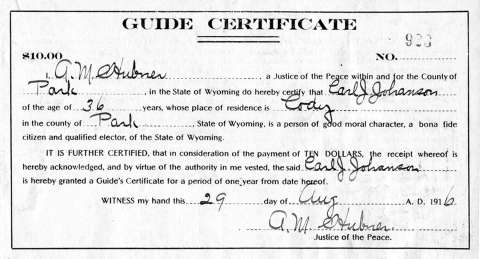
Soon after the creation of Wyoming Territory in 1869, the newly formed legislature passed its first feeble game laws, limiting the sale of game meat to a few months of the year. In the years to come, lawmakers set hunting seasons, implemented a license system and restricted daily take. These early laws were little regarded by Wyoming residents, however, and barely enforced.
New laws for guides
In 1899, the young state passed the largest package of game laws to date. This bundle of new regulations gave Wyoming an increasingly supervised hunting system and was a visible sign of progress toward a more solid foundation of game management.
Under the new game laws of 1899, non-resident hunters were required to purchase a 40-dollar hunting license. Residents were compelled to buy a one dollar “gun license,” but only if they were hunting outside of the county in which they resided.
The state also passed the first guide law, which required non-resident hunters to hire a resident guide in order to hunt within Wyoming’s borders. This provision was a reaction to the scourge of non-resident hunters who visited every year and too often did whatever they wanted regardless of local law or custom. The seasonal presence of these visiting hunters had for years been noteworthy across the state. As early as 1882, pioneer business owner Vic Arland noted the quantity of these hunters at his roadhouse on Meeteetse Creek in northwest Wyoming, telling a business associate:
We have recently had visits from a great number of Sportsmen! From New York, Chicago, Philadelphia, and other places, who come to spend a few weeks in the mountains. They were all very much surprised at the quantity and variety of game that are found in the Rockies. It is very amusing to see these gentlemen hunt. The sight of big game excites them so much they lose their level headedness.
The uninhibited vacationing hunters Arland described were ostensibly the focus of the 1899 law requiring resident guides.
Hunting guides certainly existed within the Wyoming Territory prior to the profession being regulated. Jaded buffalo hunters and other market hunters were routinely hired by itinerant hunting parties as guides who knew the landscape and the habits of local game. The 1899 guide law only made this informal business into an industry regulated by the state.
To become a guide under the 1899 law, any resident could testify to their citizenship within the state, swear they were a “person of good moral character,” and pay their 10-dollar application fee. There were no required licenses for an outfitting business and no special-use permits mandated by the U.S. Forest Service. The only thing required was an individual guide certificate.
Given this state-mandated opportunity, many cowboys, ranchers and homesteaders registered as guides to supplement their seasonal incomes. These local outdoorsmen saw an economic future for people who could mediate between hunters and wildlife in this new state-regulated conservation environment.
Protecting the game
Soon a robust industry emerged. Because the business of these early outfitters depended on non-residents being able to find game, there were now strong incentives to sustain game populations while maximizing legal take. If there was no game to hunt in the region, the business model would fail and the industry would wither.
According to the state game warden’s 1906 Annual Report, the 1899 guide law “gives guides a monopoly of the tourist hunting business and they are generally well paid for their services……Many guides have given valuable assistance in enforcing the law, and show a genuine interest in game preservation.” Clearly the law mandating resident guides for non-resident hunters created a rising tide of game protection across Wyoming that the state could not then administer itself.
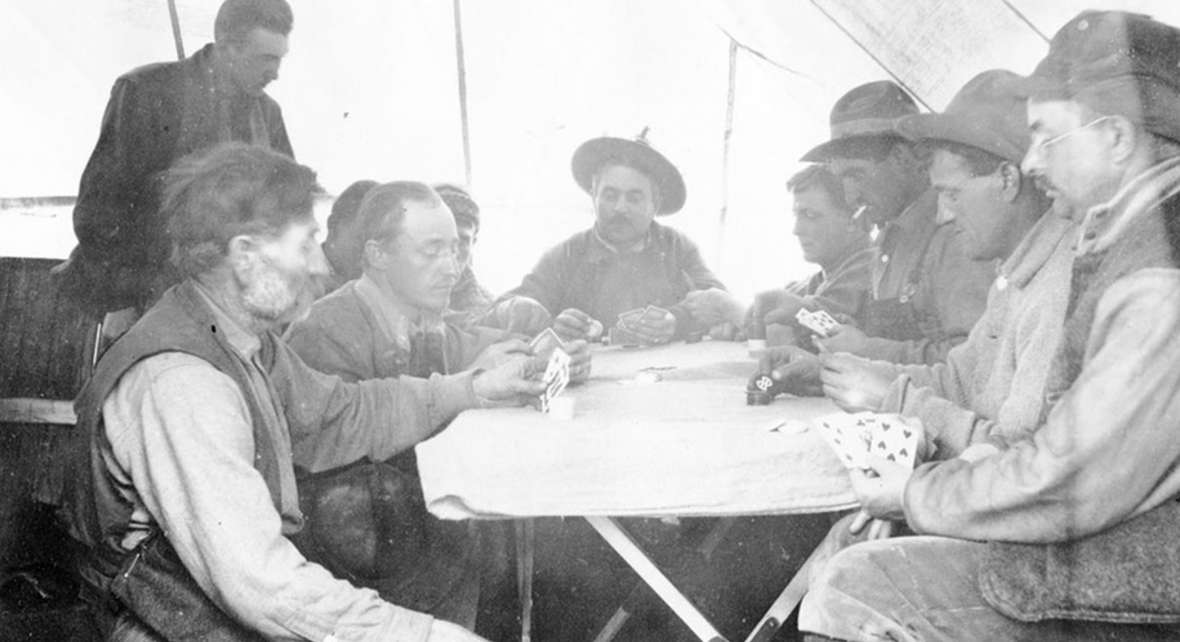
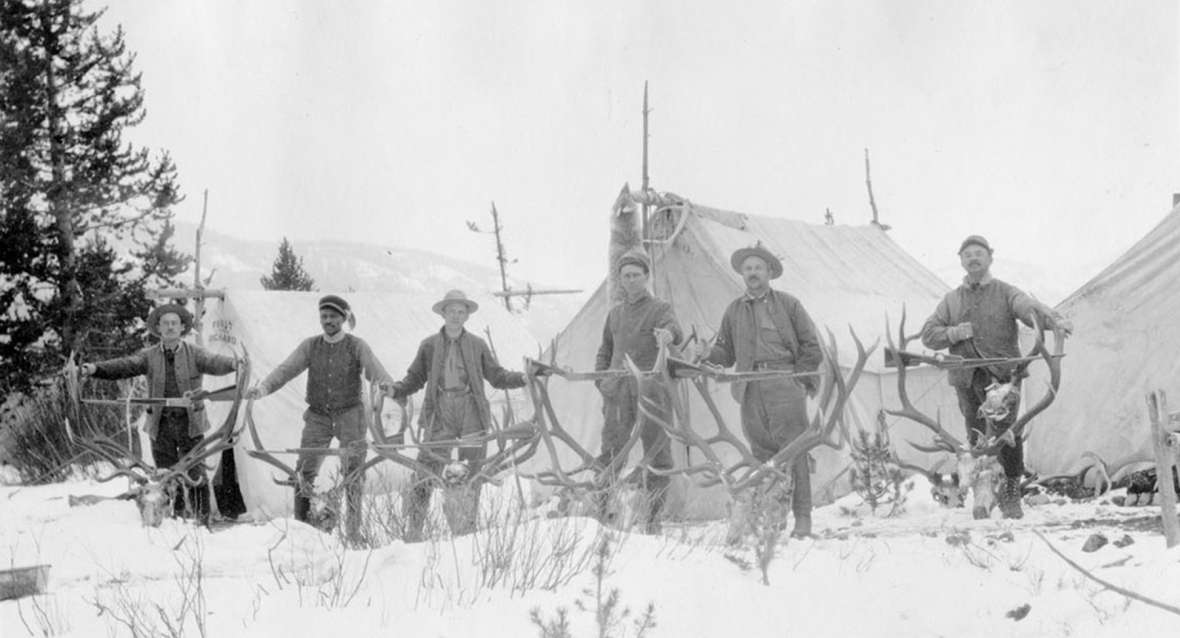
Hunters, dudes and wealth
Additionally, many early promoters of development in Wyoming—often connected with the growing outfitting industry—realized that the economic destiny of the region depended on the decisions of easterners to come out west with their their investments and connections.
There are numerous accounts of business leaders and wealthy families who first encountered the beauty of Wyoming as hunters and dudes. Many enjoyed their experiences in the West so much that they moved here, bringing their money. Local community leaders realized the importance of the outfitting business to their own future prosperity.
But the growing value of wildlife resources to local communities created new problems. Many American Indian peoples historically used Wyoming as seasonal or year-round hunting grounds. In 1868, when Wyoming Territory was about to be created, the U.S. Government successfully pressured local tribes to relinquish their historical land in exchange for designated reservations. This agreement was described in the 1868 Treaty of Fort Laramie between various tribes and the U.S. Government. The treaty also stipulated that the various tribes would maintain hunting rights upon “unoccupied lands” of their former territory.
The Bannock Tribe had just such a treaty with the U.S. Government outlining their own hunting rights in the area, an area which had previously been their territory and on which they had hunted for centuries. The controversy around the Bannock and other tribes hunting in Jackson Hole was a contentious one, with many early white settlers accusing the Indians of wantonly killing and wasting game. What followed was the so-called Bannock War of 1895, when Wyoming settlers broke the law to enforce Wyoming’s game laws against what they saw as the unlawful depredations by Native Americans.
When asked to intervene, Thomas B. Teter, the Bannock’s agent at Fort Hall, Idaho, recognized the pith of the matter when he observed that “the Indians have for many years gone to the Jackson Hole country in search of big game, and it is only since the business of guiding tourists in search of big game has become so remunerative that objection has been made to their hunting in Wyoming.”
The matter ultimately led to the Supreme Court decision in Ward v. Race Horse, where the court found that the laws of the new state of Wyoming superseded the hunting rights guaranteed the Bannocks in their earlier treaty. This legal precedent was used to deny other tribes the hunting rights they once exercised within Wyoming.
In 1922, for example, a party of Crow Indians came into the Bighorn Basin from their reservation in Montana to hunt elk. They were hastily informed by the white residents of the area of the laws requiring them to buy hunting licenses and hire hunting guides, as they were not legal residents of the state and as such were violating game laws by hunting without a registered guide. Not wanting to cause a stir, the Crow hunters apparently returned to their reservation without any elk meat.
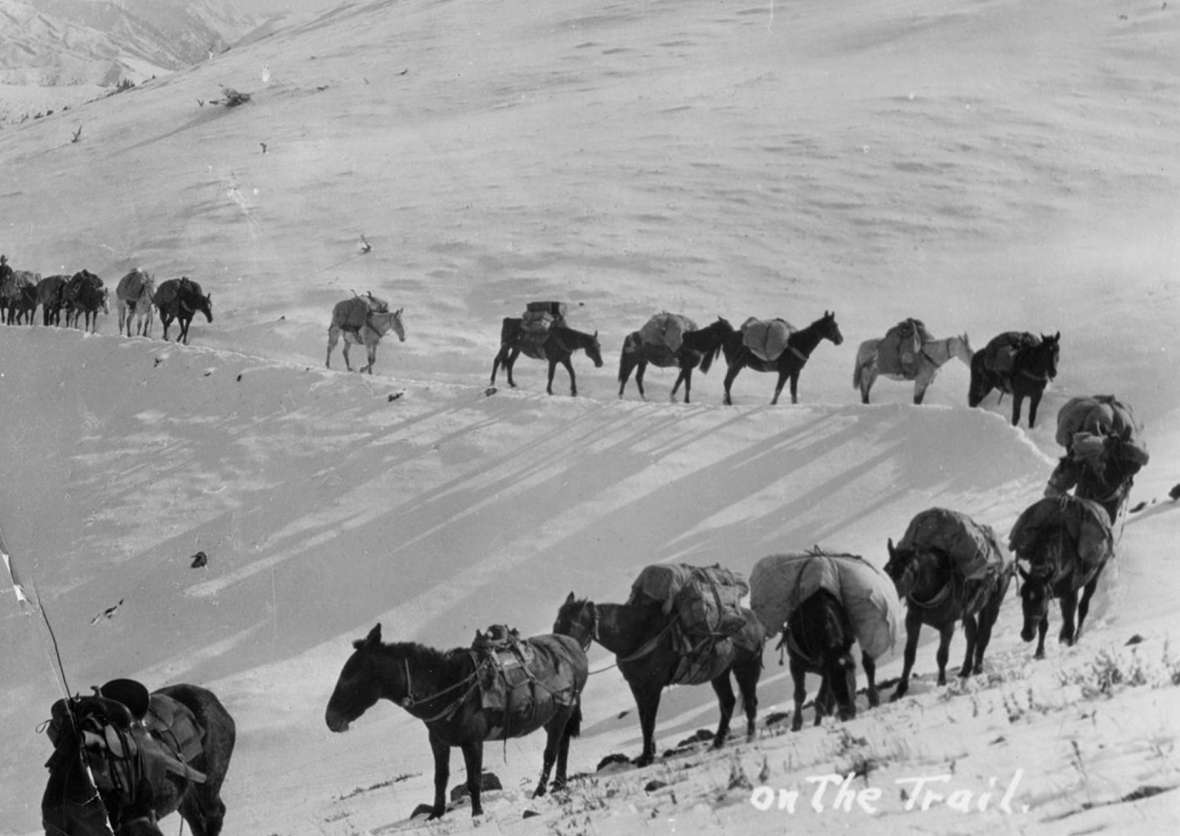
Conservation through commodification
The historical record is very clear that outfitters, guides, dude ranchers and other community leaders desperately wanted wealthy hunters to visit Wyoming. Hoping to realize greater settlement and economic growth, local boosters wagered that these important guests might become so romanced by their western experience that they would themselves invest capital in the area.
Given the benefits nonresident hunters brought to rural communities, it was imperative that wildlife populations were well managed to maintain the local economy around selling hunting access to paying sportsmen. And by defining wildlife as a “public” resource, early conservationists deflected charges that the local population of subsistence hunters was being marginalized to create a wilderness playground for the rich.
The original 1899 guide law largely did what it was intended to do. Of course, all guides were not perfect, and some broke the law themselves. But the industry helped rein in the recklessness of the worst non-resident hunters, and also kept local sportsmen on the straight and narrow as they began to view local wildlife as an important economic commodity, not simply the fat of the land to be wantonly killed.
Non-resident hunters were never big fans of the guide law, understandably. And this antagonism reinforced the notion that non-residents were more concerned about their own opportunity to hunt than about protecting Wyoming’s wildlife. In 1973, after years of grumbling by out-of-state hunters, the Wyoming Attorney General ruled that the 1899 guide law was “legally inadequate and discriminatory,” essentially invalidating the entire mandate.
In 1975 the Wyoming legislature, pressured from the Wyoming Outfitters and Guides Association, passed an updated law requiring non-resident hunters to employ Wyoming outfitters and guides only while hunting in federally designated Wilderness Areas.
A few years later the Wyoming Supreme Court found that this 1975 guide law discriminated against non-resident guides because it expressly required a Wyoming guide and outfitter. The law was again changed to limit non-Wyoming guides and outfitters from taking more than two hunters into designated wilderness areas.
A modern debate
There have been continuing “conversations” about set-aside tags for non-resident hunters who hire guides and the general allocation scheme regarding resident and non-resident tags in Wyoming.
It is a legitimate question why American citizens who are not residents of Wyoming are still required to hire a guide to hunt on public land in federally designated wilderness areas when they can legally hike and fish on those same lands without a guide.
While many people today make the case that the modern Wyoming guide law is less about wildlife conservation and more about allowing guides and outfitters to profit from the allocation of non-resident hunting licenses, it is also important to understand that the original 1899 guide law did a great deal to save Wyoming’s game populations from being exterminated—as the buffalo had been—because it gave Wyoming residents an economic reason to protect local wildlife. Whether the current guide law still accomplishes, or is even meant to accomplish, the same goal is a very open question.
According to a 2015 study commissioned by the Wyoming Outfitters and Guides Association, hunting contributes roughly $250 million annually to the Wyoming economy. And while only 40% of all hunters in Wyoming are nonresidents, that minority percentage generates a disproportionate amount of economic activity. Out-of-state hunters account for 85% of the clientele for Wyoming hunting guides and outfitters, amounting to $52.8 million dollars in annual proceeds.
As part of the larger tourism and outdoor recreation sectors of Wyoming’s economy, hunting has proven it can bring much needed revenue to rural communities with ample wildlife and easy access to public land. That being said, those who stand to profit most from the Wyoming hunting industry—outfitters and guides—must remain a strong and dedicated force for habitat conservation and healthy wildlife populations if the arrangement is to be legitimate and sustained into the future.
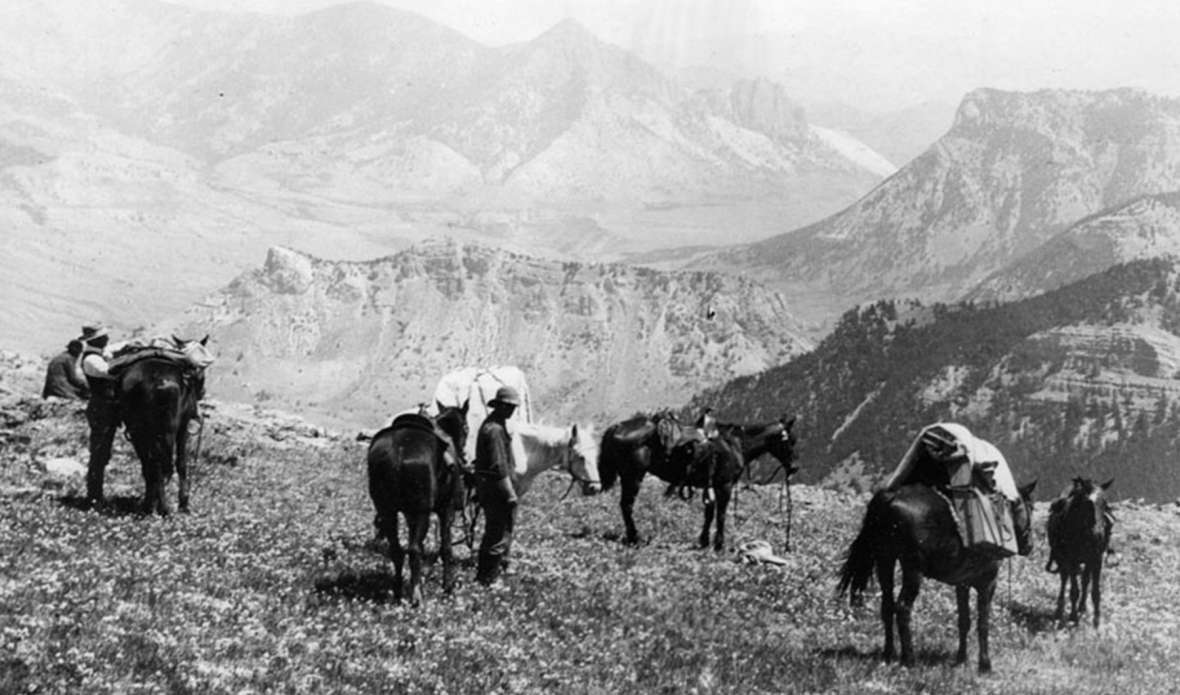
Resources
Primary Sources
- Arland, Victor. Letter, October 18, 1882. McCracken Research Library, Buffalo Bill Center of the West, Cody, Wyo.
- “Big Money: Economic Contributions of Big Game Hunting in Wyoming.” 2015, https://wyoga.org/wp-content/uploads/pdf/studies/southwickstudy/Southwic... _report_WEB.pdf
- .G. Gates and Party on Hunt.” Park County Enterprise, Sept. 27, 1913.
- .G. Gates Dies Suddenly in Car.” New York Times, Oct. 29, 1913.
- “Charles G. Gates Ranked ‘Ace High’ in Cody, Wyoming.” New York Times, Nov. 23, 1913.
- Frost, Ned. “My Sixty Years of Western Hunting.” Sports Afield (October 1952), 27-31, 88-95.
- “Ned Frost Tells how to Save Wyoming Elk from Extinction.” Park County Enterprise, May 15, 1912.
- “Gates The Multi-Millionaire is Also a Mighty Hunter.” Northern Wyoming Herald, Oct. 24, 1913.
- “Indians Must Hire Guides to Hunt Elk.” Cody Enterprise, Oct. 4, 1922.
- “Multi-Millionaire Gates After Big Game-Equipped for Business.” Northern Wyoming Herald, Sept. 26, 1913.
- “’Spend-A-Million’ Gates at Cody to Join Prince of Monaco in Hunt.” Denver Post, Sept. 25, 1913.
- Wyoming Game and Fish Department. Report of the State Game Warden of Wyoming, 1895 to 1910.
Secondary Sources
- Beauvais, Brian. “Sportsmen, Market Hunters, & Game Hogs: The Early Years of Wildlife Conservation in Park County.” Annals of Wyoming 92, No. 4 (Autumn 2020-Winter 2021), 36-57.
- Blair, Neal. The History of Wildlife Management in Wyoming. Cheyenne, Wyo: Wyoming Game and Fish Department, 1987.
- Bonner, Robert. William F. Cody’s Wyoming Empire: The Buffalo Bill Nobody Knows. Norman, Okla.: University of Oklahoma Press, 2007.
- Chamberlin, Agnes. The Cody Club: 1900-1999, Edited by Jeannie Cook and Joanita Monteith. Cody, Wyo: Yellowstone Printing & Design, 1999.
- Czech, Brian. “Elk Hunting in the Shadow of Ward vs. Racehorse: Ten Bear and the Crow Tribe.” Journal of the West 39, no. 1 (January 2000), 64-71.
- Frost, Dick. Tracks, Trails, and Tales: “The Legacy of Ned Frost.” Cody, Wyo: D. Frost, private printing, 1984.
- “Indian Disturbances In ‘Jackson Hole’ Country, Wyoming, 1895” Annals of Wyoming 16 No.1 (January, 1944), 5-33.
- Jacoby, Karl. Crimes Against Nature: Squatters, Poachers, Thieves, and the Hidden History of American Conservation. Berkeley: University of California Press, 2014.
- King, Calvin. History of W-I-L-D-L-I-F-E in the Big Horn Basin of Wyoming. Cheyenne, Wyo: Pioneer Printing, 1992.
- Warren, Louis S. The Hunter's Game: Poachers and Conservationists in Twentieth Century America. New Haven: Yale University Press, 1997.
Illustrations
- All the photos are from the collections of the Park County Archives, Cody, Wyo. Used with permission and thanks.
